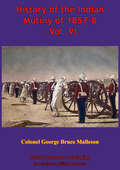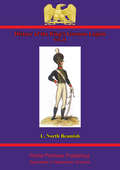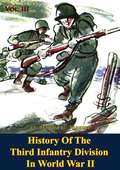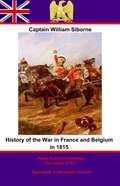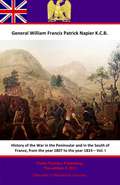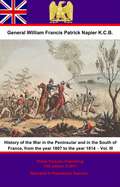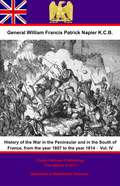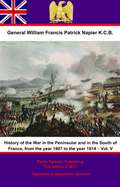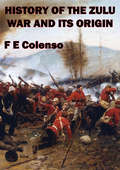- Table View
- List View
History Of The Indian Mutiny Of 1857-8 – Vol. V [Illustrated Edition] (History Of The Indian Mutiny Of 1857-8 Ser. #5)
by Colonel George Bruce Malleson[Illustrated with over one hundred maps, photos and portraits, of the battles of the Indian Mutiny]By 1857, British power in India had been largely undisputed for almost fifty years, however, the armies of the East India Company were largely recruited from the native people of India. This inherent weakness would be exposed during the events of the Indian Mutiny of 1857-1858, as the Sepoy soldiers turned against their erstwhile British employers.The events that led up to the Revolt were many and varied, including British highhandedness, ignorance of local customs and religious values, and incendiary propaganda. It is generally argued that the spark that lit the flame was the rumour that the newly issued rifle cartridges would be greased either with tallow, derived from beef and thereby offensive to Hindus, or lard, derived from pork and thereby offensive to Muslims. The enraged soldiers mutinied across a number of Indian States, taking Delhi, besieging Lucknow, and revolting in Oudh.The rebellion was eventually quelled in 1858 however, the effects of the Mutiny were far ranging and important. The East Indian Company was dissolved and the British government set about reorganising all facets of its power in India from the political to the administration and, most pointedly, the military. Although India would not gain its Independence until 150 years later, the events of the Indian Mutiny stayed in the folk consciousness of the country, a number of the leaders were lionized in certain circles, and a measure of nascent nationhood was born.Of the many books written on the event, few are as well respected, accurate, frequently read or cited as the six volume history produced by two ex-British Army officers, Sir John Kaye and Colonel George Malleson, who had both erved extensively in India. This fifth volume deals with the effects of the revolt outside of the North-Western Provinces and discusses the causes of the revolt.
History Of The Indian Mutiny Of 1857-8 – Vol. VI [Illustrated Edition] (History of the Indian Mutiny of 1857-8 #6)
by Colonel George Bruce MallesonBy 1857, British power in India had been largely undisputed for almost fifty years, however, the armies of the East India Company were largely recruited from the native people of India. This inherent weakness would be exposed during the events of the Indian Mutiny of 1857-1858, as the Sepoy soldiers turned against their erstwhile British employers.<P><P> The events that led up to the Revolt were many and varied, including British highhandedness, ignorance of local customs and religious values, and incendiary propaganda. It is generally argued that the spark that lit the flame was the rumour that the newly issued rifle cartridges would be greased either with tallow, derived from beef and thereby offensive to Hindus, or lard, derived from pork and thereby offensive to Muslims. The enraged soldiers mutinied across a number of Indian States, taking Delhi, besieging Lucknow, and revolting in Oudh.<P> The rebellion was eventually quelled in 1858 however, the effects of the Mutiny were far ranging and important. The East Indian Company was dissolved and the British government set about reorganising all facets of its power in India from the political to the administration and, most pointedly, the military. Although India would not gain its Independence until 150 years later, the events of the Indian Mutiny stayed in the folk consciousness of the country, a number of the leaders were lionized in certain circles, and a measure of nascent nationhood was born.<P> Of the many books written on the event, few are as well respected, accurate, frequently read or cited as the six volume history produced by two ex-British Army officers, Sir John Kaye and Colonel George Malleson, who had both erved extensively in India. <P> This sixth volume deals with the effects of the revolt in the districts/areas not previously covered – Sindh, Agra and Rohilkhand, the civil districts, and the Navy.
History Of The International: World Socialism 1943-1968
by Julius BraunthalWith this volume the history of the first century of the International reaches its conclusion. Originally I had intended that the trilogy would come to a close with the centenary of the founding of the First International in September 1964. But before I could finish writing the third volume the tragedy of the Communist revolution in Czechoslovakia had played itself out. 'The Spring of Prague' of 1968, having set in motion a process of change from a Communist dictatorship to a Socialist democracy, was followed within a few months by the invasion of the armies of the five Warsaw Pact powers to forestall reformation in Czechoslovakia. Both revolution and counter-revolution were events of the utmost significance for the history of Socialism-the revolution, for showing that it was possible for a Communist system of totalitarian dictatorship to be transformed without resort to force; and the counter-revolution, for showing how the regime in the Soviet Union has remained essentially unaltered since Stalin's death. The invasion of Czechoslovakia brutally called in question any optimistic perspective of development within the Soviet Union itself.
History Of The Island Of Domi: Containing A Description Of Its Situation, Extent, Climate, Mountains, Rivers, Natural Productions, Andc. Andc. T
by Thomas AtwoodFirst Published in 1971. Routledge is an imprint of Taylor & Francis, an informa company.
History Of The Italian People
by Guiliano Procacci Giuliano ProcacciFrom the early years, when its cities and towns were self-governing, to the national rise to power of fascism this century, Italy has undergone many upheavals: political, social, economic and cultural. Pinpointing the year A.D. 1000 as a time when European supremacy began to take root, the author traces Italy's progression within its European context. Communes of the 11th century to the birth of the European Renaissance and on to the role of Italy in two world wars, this study of a people's evolution won the author the Viareggio Prize.
History Of The King’s German Legion Vol. I (History of the King’s German Legion #1)
by N. Ludlow Beamish"Ludlow Beamish's famous history of the K.G.L. is undoubtedly one of the rarest and most sought-after contemporary studies of the Napoleonic Wars. Much praised by Sir Charles Oman as 'a valuable and conscientious' history, it was largely compiled from eye-witness accounts of serving soldiers. The Legion played a major part in the British Army in the Peninsula and this special edition is a vital addition to the library of all serious students of the Napoleonic Wars.One of the most unusual, as well as the most heroic and distinguished Allied units in the Napoleonic Wars was the King's German Legion (KGL). Originally composed of German volunteers from King George III's Hanoverian domain, and founded out of Royal outrage at France's occupation of Hanover in 1803, the KGL, according to David Chandler, doyen of Napoleonic military historians 'was without a doubt amongst the very best troops commanded by Wellington in the Peninsula and at Waterloo'. The KGL was a mini-army in its own right, comprising infantry, cavalry and artillery... Volume 1 begins with the bungled loss of Hanover and the raising of the KGL, and its first foreign expedition - to Denmark under Lord Rosslyn. The KGL was next deployed in the Mediterranean theatre, and had its first taste of Spain under Sir John Moore and Sir Arthur Wellesley (Wellington) where the German hussars covered the disastrous retreat to Corunna. The Legion returned to Portugal and Spain with Wellington and lost heavily at the Battle of Talavera. Other KGL units took part in Sir Eyre Coote's expedition to Flushing and Walcheren. In the Peninsula War, the Legion fought under General Craufurd, helping to defeat the French at Busaco and before the lines of Torres Vedras, and later participating in Wellington's victory over Marshal Massena at Fuentes d'Oñoro. The volume ends with Soult's defeat at Albuera and the siege of Badajoz."-N&M Print version
History Of The King’s German Legion Vol. II (History of the King’s German Legion #2)
by N. Ludlow Beamish"Ludlow Beamish's famous history of the K.G.L. is undoubtedly one of the rarest and most sought-after contemporary studies of the Napoleonic Wars. Much praised by Sir Charles Oman as 'a valuable and conscientious' history, it was largely compiled from eye-witness accounts of serving soldiers. The Legion played a major part in the British Army in the Peninsula and this special edition is a vital addition to the library of all serious students of the Napoleonic Wars.One of the most unusual, as well as the most heroic and distinguished Allied units in the Napoleonic Wars was the King's German Legion (KGL). Originally composed of German volunteers from King George III's Hanoverian domain, and founded out of Royal outrage at France's occupation of Hanover in 1803, the KGL, according to David Chandler, doyen of Napoleonic military historians 'was without a doubt amongst the very best troops commanded by Wellington in the Peninsula and at Waterloo'. The KGL was a mini-army in its own right, comprising infantry, cavalry and artillery... Volume 2 opens with the sieges of Badajoz and Cieudad Roderigo and the great battle of Salamanca which broke the back of the French in Spain. As Wellington rolled the enemy up to the Pyrenees, the KGL wewre also present at the battle of Vittoria. Meanwhile the KGL were also operating against Marshal Davout in the noirth of their native Germany. The Allied pressure caused Napoelon to abdicate and retire to Elba in 1814. The book's final chapter deals with the Waterloo campaign in which the KGL played a heroic part in holding the strategically vital La Haye Sainte Farm in front of the British line, against furious French assaults.."-N&M Print version
History Of The Ottawa And Chippewa Indians Of Michigan
by Andrew BlackbirdFrom the intro: "Andrew J. Blackbird, the author of this little book, is an educated Indian, son of the Ottawa Chief. His Indian name is Mack-aw-de-be-nessy (Black Hawk), but he generally goes by the name of "Blackbird," taken from the interpretation of the French "L'Oiseau noir." Mr. Blackbird's wife is an educated and intelligent white woman of English descent, and they have four children. He is a friend of the white people, as well as of his own people. Brought up as an Indian, with no opportunity for learning during his boyhood, when he came to think for himself, he started out blindly for an education, without any means but his brains and his hands. He was loyal to the Government during the rebellion in the United States, for which cause he met much opposition by designing white people, who had full sway among the Indians, and who tried to mislead them and cause them to be disloyal; and he broke up one or two rebellious councils amongst his people during the progress of the rebellion."
History Of The Port Phillip District: Victoria before Separation
by Shaw A.G.LThis major new history is an account of the establishment of European settlement in what is now the State of Victoria. The period from the first temporary convict camp of 1803 to the formal separation of Victoria from New South Wales in 1851 encompassed years of struggle, adversity and uncertainty. These are the years which Professor Shaw examines in his detailed narrative &mdash years which saw the future of the territory shaped by diverse figures: Aborigines, whalers, adventurers, squatters, speculators and immigrants. This is the first general history of pre-goldrush Victoria in more than ninety years. It incorporates the advances in documentation and scholarship that have taken place since that time. In particular it draws upon the correspondence between officials in Melbourne, Sydney and London, and on the Batman, Swanston, Port Phillip Association and La Trobe papers. The story begins with the British government's decision to make a settlement on the shores of Bass Strait, and with a study of the Aboriginal inhabitants of Port Phillip as they were at the dawn of the nineteenth century. An account of the beginnings of Melbourne, marked by the arrival of John Batman and John Pascoe Fawkner, leads on to the topics of squatting, speculation, immigration, economic depression and recovery, and ends with an examination of the issues which led to the separation of the district from New South Wales. The book is illustrated in colour with contemporary paintings, many of which will be unfamiliar to most readers.
History Of The Siege Of Delhi [Illustrated Edition]
by Anon - “Officer who served there”[Illustrated with over one hundred maps, photos and portraits, of the battles, individuals and places involved in the Indian Mutiny]The Indian Mutiny, or Sepoy Revolt, flared up in many areas around the British controlled Raj in 1857. Government offices were sacked and many Europeans were put to the sword, the reasons for this sudden explosion of violence were many; religious affronts, British high-handedness and to some freedom from Imperialism. Delhi fell quickly to the rebels overcoming the small garrison and occupying the huge arsenal. As the former capital of the Mughal Empire Delhi was a beacon for those who sought to reinstate native control, many rebellious sepoys flocked to the city and the importance of Delhi as a symbol of the revolt gathered momentum by the day. The British forces, having recovered from the shock, understood the importance of Delhi as a focal point of resistance and dispatched a large force to retake the city, trusting in discipline and organised fighting power of the troops. The Siege of Delhi was pivotal to the entire Indian Mutiny and both sides were very aware of this, the fighting was among the bloodiest of the entire struggle. This account by an anonymous serving officer is a fabulously detailed account of the siege, full of the ebb and flow of the fortunes of the British besiegers as they sought to crush the rebellion.
History Of The Third Infantry Division In World War II, Vol. I (History Of The Third Infantry Division In World War II #1)
by Lt. Donald G. TaggartFew units in the U.S. Army can boast as proud a unit history as the Third Infantry Division; it fought on all of the Europe and North African fronts that American soldiers were engaged against the Axis forces during World War II. The 3rd Infantry Division saw combat in North Africa, Sicily, Italy, France, Germany and Austria for 531 consecutive days. In this official division history written by the officers who served with the unit at the time serves as a fascinating memorial and a detailed history of the "Marne Division" during World War II.The 3rd Inf. Division made landfall in Fedala on the 8th November 1942 as part of Operation Torch during the Allied invasion of North Africa and was engaged in heavy fighting before the German and Italian troops were finally levered out of the continent. The division was back in the thick of the fighting in Sicily under the command of such famous leaders as Generals Lucien Truscott, Omar Bradley and George S. Patton. As part of General Mark Clark's U.S. Fifth army it engaged in some of the bloodiest engagements of the Italian campaign at Salerno beaches, Volturno river, Monte Cassino and Anzio. Under their old division commander General Truscott they formed part of the force that landed in Southern France and battled into the heart of Germany before the eventual capitulation of the Nazi High command in 1945.Richly illustrated with maps and pictures throughout.
History Of The Third Infantry Division In World War II, Vol. II (History Of The Third Infantry Division In World War II #2)
by Lt. Donald G. TaggartFew units in the U.S. Army can boast as proud a unit history as the Third Infantry Division; it fought on all of the Europe and North African fronts that American soldiers were engaged against the Axis forces during World War II. The 3rd Infantry Division saw combat in North Africa, Sicily, Italy, France, Germany and Austria for 531 consecutive days. In this official division history written by the officers who served with the unit at the time serves as a fascinating memorial and a detailed history of the "Marne Division" during World War II.The 3rd Inf. Division made landfall in Fedala on the 8th November 1942 as part of Operation Torch during the Allied invasion of North Africa and was engaged in heavy fighting before the German and Italian troops were finally levered out of the continent. The division was back in the thick of the fighting in Sicily under the command of such famous leaders as Generals Lucien Truscott, Omar Bradley and George S. Patton. As part of General Mark Clark's U.S. Fifth army it engaged in some of the bloodiest engagements of the Italian campaign at Salerno beaches, Volturno river, Monte Cassino and Anzio. Under their old division commander General Truscott they formed part of the force that landed in Southern France and battled into the heart of Germany before the eventual capitulation of the Nazi High command in 1945.Richly illustrated with maps and pictures throughout.
History Of The Third Infantry Division In World War II, Vol. III (History Of The Third Infantry Division In World War II #3)
by Lt. Donald G. TaggartFew units in the U.S. Army can boast as proud a unit history as the Third Infantry Division; it fought on all of the Europe and North African fronts that American soldiers were engaged against the Axis forces during World War II. The 3rd Infantry Division saw combat in North Africa, Sicily, Italy, France, Germany and Austria for 531 consecutive days. In this official division history written by the officers who served with the unit at the time serves as a fascinating memorial and a detailed history of the "Marne Division" during World War II.The 3rd Inf. Division made landfall in Fedala on the 8th November 1942 as part of Operation Torch during the Allied invasion of North Africa and was engaged in heavy fighting before the German and Italian troops were finally levered out of the continent. The division was back in the thick of the fighting in Sicily under the command of such famous leaders as Generals Lucien Truscott, Omar Bradley and George S. Patton. As part of General Mark Clark's U.S. Fifth army it engaged in some of the bloodiest engagements of the Italian campaign at Salerno beaches, Volturno river, Monte Cassino and Anzio. Under their old division commander General Truscott they formed part of the force that landed in Southern France and battled into the heart of Germany before the eventual capitulation of the Nazi High command in 1945.Richly illustrated with maps and pictures throughout.
History Of The U. S. Volume 1 Beginnings to 1877
by William Jay Jacobs Lorna C Mason Robert P LudlumIn this history of the American people, we begin with the Native Americans and conclude with the Civil War and its aftermath. We show how the territory and people of the United States reflect an Indian, British, African, French, and Spanish heritage. We try to show the drama of the past, the agonies as well as the joys. We try to show the consequences of decisions made, and of decisions not made. Most of all, we try to make the past meaningful to you as you prepare yourself for life in the twenty-first century.
History Of The United States
by Christian G. Appy Houghton Mifflin Company Staff Lorna C. Mason Thomas V. DibaccoHistory of the United States was designed with three goals in mind:<P> 1. To provide thorough coverage of American history from earliest times to the present, with special emphasis on the twentieth century.<P> 2. To identify the major themes in American history and explain their importance at each stage in the development of the United States.<P> 3. To convey a sense of the breadth of experiences and influences that have shaped the United States.
History Of The War In France And Belgium In 1815. 3rd Edition
by Pickle Partners Publishing Captain William SiborneThis ebook is purpose built and is proof-read and re-type set from the original to provide an outstanding experience of reflowing text for an ebook reader. When Captain Siborne died in 1849, it is unlikely that he was aware of the enduring historical legacy that he was to leave behind. His History of the War in France and Belgium in 1815 has become the most well known English history of the famous campaign and despite being written over 150 years ago is still in print, still eminently readable and remarkably accurate. The book was the result of his life's work and passionate dedication to the "Waterloo Model" which depicts a stage of the battle in tremendous detail. The accuracy of the book is accounted for by four tremendously important points; Firstly, Siborne was engaged by the British military establishment to produce a model of the battle of Waterloo, which he did with scrupulous accuracy including painstaking research on the battle ground and environs including surveys of the ground. Secondly, Siborne was a noted topographical engineer who wrote a number of treatises and one of the standard works of the time enabling his appreciation of the battle to be precise and avoid fault of many histories written merely from maps (some produced years afterward)of the area. Thirdly, he undertook what was a the time a ground-breaking "questionnaire" of the surviving officers of the British, King's German Legion, Hanoverian units involved, to piece together the events of the day. These letters were published in part by Siborne's son much later. Fourthly he expanded his search for eye-witness testimony to both the Prussian and French army staffs, and although rebuffed by the French, who were understandably tender about the loss of the battle and their Emperor with it, his enquiries were fruitful amongst the Prussian command who supplied a priceless counterbalance to the sometimes jingoistic British accounts. Siborne and his works were ahead of their time, and his search for an accurate representation of the battle won him few friends at Horse Guards. Funding was difficult to obtain from the British establishment and Siborne's attempts at self-funding the model which was his life's work were unsuccessful, Siborne died a broken man. He left behind the "Waterloo Model" and a larger scale model which are housed at the Royal Army Museum in London and this excellent book. We chose the third edition as it includes the impassioned defence of his work against the plagiarism of Rev R Gleig's "Story of Waterloo" and a number of notable changes from the first and second editions prompted by further eye-witness testimony gathered by Siborne. Text taken, whole and complete, from the 1848 third edition, published in London by T and W Boone Original - 667 pages. Author - Captain William Siborne (15 October 1797-9 January 1849) Linked TOC. - in keeping with the format of the times that the book was published the table of contents includes the summary notes of each chapter.
History Of The War In The Peninsular And In The South Of France, From The Year 1807 To The Year 1814 – Vol. I (History Of The War In The Peninsular And In The South Of France, From The Year 1807 To The Year 1814 #1)
by General William Francis Patrick Napier K.C.B.William Napier, was born in Dublin in 1785, one of a number of brothers who entered the British army and excelled in the service although it is his History of the War in the Peninsular that he is most remembered for. A masteful, epic account of the Spanish Ulcer that drained Napoleon's resources and played a pivotal role in the end of his domination of Europe.<P><P> Napier gained his first commission as an ensign in the Royal Irish Artillery in 1800. By the time of the Napoleonic Wars he had transferred to to the 52nd Regiment, which was being trained as light infantry at Shorncliffe under Sir John Moore. Napier saw his first service in the Peninsular with the 43rd Foot under Sir John Moore during the Corunna campaign. Napier would go on to be conspicuous in the actions of the Light Division, such as the epic march to Talavera, the battles of Fuentes d’Oñoro, Salamanca, Nivelle, Orthes and Toulouse. He left the service a General and Knight Commander of the Order of Bath.<P> In this first volume (1807 to beginning of 1809), Napier surveys the scene in mainland Europe and particularly Spain and Portugal, the rotten state of politics in Spain, the isolation of Portugal as the only ally of Great Britain still not under Napoleon’s domination. He starts with the machinations of the French to supplant the Bourbon regime in Spain and the joint Franco-Spanish invasion of Portugal with its flood of French troops supposed friends soon to be enemies. The initial disastrous campaigns of the splintered Spanish armies are written of in great detail, battles such as Rio Seco and Ucles, and the parlous state of the Spanish government are shown in all their infamy, juxtaposed to the second defence of Sarragossa by the valorous Spaniards. Wellington’s first short-lived campaign in Portugal, including the battle of Vimiero is given due attention and much is lavished on the campaign of Sir John Moore.<P> A Classic, deserves to be read and re-read.
History Of The War In The Peninsular And In The South Of France, From The Year 1807 To The Year 1814 – Vol. II (History Of The War In The Peninsular And In The South Of France, From The Year 1807 To The Year 1814 #2)
by General William Francis Patrick Napier K.C.B.A masterful, epic account of the Spanish Ulcer that drained Napoleon's resources and played a pivotal role in the end of his domination of Europe.The author served with distinction in the actions of the Light Division, such as the epic march to Talavera, the battles of Fuentes d'Oñoro, Salamanca, Nivelle, Orthes and Toulouse. He left the service a General and Knight Commander of the Order of Bath. Napier's History would rank as the most important history to be written by an actual participant, and was as controversial with his countrymen as amoung his contemporaries on the Continent. ]Continuing on from his first volume, Napier's second volume focuses on the period (late 1808-mid 1810). Starting in earnest with the second French invasion of Portugal, and the re-introduction of the Duke of Wellington to the Peninsular, having being called back to England to face a Court of Inquiry over the convention of Cintra [by whom he was exonerated fully, even praised]. The state of Portugal's defence is assessed, brave soldiers but not organised into an army as yet, and the far-reaching appointment of the English general William Carr Beresford as Portuguese Marshal detailed along with the militia raised in the provinces. Thus with inauspicious beginnings Wellington, begins his first full campaign in the Peninsula. The lightning capture of Porto and the pursuit of Soult's Army of Portugal then ensue before Wellington makes his first foray into Spain. Culminating in the battle of Talavera, although on paper won bloodily, and a somewhat dangerous retreat follow, the fruits of bad co-operation of the parts of the Allies bordering on malign behaviour.Napier goes to some trouble to cover all areas of the Peninsular, not just those that the British soldiers were directly involved in.
History Of The War In The Peninsular And In The South Of France, From The Year 1807 To The Year 1814 – Vol. III (History Of The War In The Peninsular And In The South Of France, From The Year 1807 To The Year 1814 #3)
by General William Francis Patrick Napier K.C.B.A masterful, epic account of the Spanish Ulcer that drained Napoleon's resources and played a pivotal role in the end of his domination of Europe.The author served with distinction in the actions of the Light Division, such as the epic march to Talavera, the battles of Fuentes d’Oñoro, Salamanca, Nivelle, Orthes and Toulouse. He left the service a General and Knight Commander of the Order of Bath. Napier’s History would rank as the most important history to be written by an actual participant, and was as controversial with his countrymen as amoung his contemporaries on the Continent. In this third volume (Mid-1810 to Sept 1811), covers the third French invasion of Portugal under Massena, although he outnumbers his British and Portuguese opponents is beset by problems, not the least of which are his sub-ordinates who are loath to obey him. As he drives into Portugal he is given a bloody nose at the battle of Busaco, and a horrible surprise at the lines of Torres Vedras, which are impregnable. Forced to retire through devastated countryside, culminating in the battle of Fuentes D’Oñoro as he tries to relieve the garrison of Almeida, which had been left behind. All in all the French would never set foot in force again in Portugal and Wellington’s strategies would be vindicated.However Napier put these events in their proper context, the seemingly inexorable march to an Allied victory is far from the reality of the situation; an expedition to Fuengirola under Lord Blayney is routed, British expeditions along the Eastern coast of Spain are foiled and in the case of Taragona, it falls in sight of the force sent to aid it. The Regency of Portugal and the court in Brazil intrigue and cause trouble and strife, the Spanish troops start to rack up some small scale victories but are handled and led badly in most cases. The detached corps of Marshal Beresford fights the bloody battle Albuera, Napier is none too kind in his criticisms of his actions.
History Of The War In The Peninsular And In The South Of France, From The Year 1807 To The Year 1814 – Vol. III (History Of The War In The Peninsular And In The South Of France, From The Year 1807 To The Year 1814 #6)
by General William Francis Patrick Napier K.C.B.A masterful, epic account of the Spanish Ulcer that drained Napoleon's resources and played a pivotal role in the end of his domination of Europe.<P><P> The author served with distinction in the actions of the Light Division, such as the epic march to Talavera, the battles of Fuentes d’Oñoro, Salamanca, Nivelle, Orthes and Toulouse. He left the service a General and Knight Commander of the Order of Bath. Napier’s History would rank as the most important history to be written by an actual participant, and was as controversial with his countrymen as amoung his contemporaries on the Continent. In this third volume (Mid-1810 to Sept 1811), covers the third French invasion of Portugal under Massena, although he outnumbers his British and Portuguese opponents is beset by problems, not the least of which are his sub-ordinates who are loath to obey him. As he drives into Portugal he is given a bloody nose at the battle of Busaco, and a horrible surprise at the lines of Torres Vedras, which are impregnable. Forced to retire through devastated countryside, culminating in the battle of Fuentes D’Oñoro as he tries to relieve the garrison of Almeida, which had been left behind. All in all the French would never set foot in force again in Portugal and Wellington’s strategies would be vindicated.<P> However Napier put these events in their proper context, the seemingly inexorable march to an Allied victory is far from the reality of the situation; an expedition to Fuengirola under Lord Blayney is routed, British expeditions along the Eastern coast of Spain are foiled and in the case of Taragona, it falls in sight of the force sent to aid it. The Regency of Portugal and the court in Brazil intrigue and cause trouble and strife, the Spanish troops start to rack up some small scale victories but are handled and led badly in most cases. The detached corps of Marshal Beresford fights the bloody battle Albuera, Napier is none too kind in his criticisms of his actions.
History Of The War In The Peninsular And In The South Of France, From The Year 1807 To The Year 1814 – Vol. IV (History Of The War In The Peninsular And In The South Of France, From The Year 1807 To The Year 1814 #4)
by General William Francis Patrick Napier K.C.B.A masterful, epic account of the Spanish Ulcer that drained Napoleon's resources and played a pivotal role in the end of his domination of Europe.<P><P> The author served with distinction in the actions of the Light Division, such as the epic march to Talavera, the battles of Fuentes d’Oñoro, Salamanca, Nivelle, Orthes and Toulouse. He left the service a General and Knight Commander of the Order of Bath. Napier’s History would rank as the most important history to be written by an actual participant, and was as controversial with his countrymen as amoung his contemporaries on the Continent.<P> In this fourth volume (end-1811 to December 1812), covers the major Anglo-Portuguese offensive of 1812, whilst Napoleon embarks on his disastrous campaign to Russia, Wellington struck into mainland Spain. Although hampered by numerous supply issues, not least caused by the Spanish government or lack thereof, Wellington drove through the southern corridor between Portugal and Spain, taking the key fortresses of Cuidad Rodrigo and Badajoz. The last siege was a particularly bloody affair and cost Wellington a great many soldiers ending in an infamous orgy of lotting. Wellington manoeuvred to keep his prizes whilst Marmont with a similarly sized French army sought to cut him off from Portugal. These movement culminated in the battle of Salamanca, which was described at the time by a French officer, as the 'beating of forty thousand men in forty minutes.'. It was a masterpiece of timing and skill, and is widely regarded as Wellington’s masterpiece.<P> Despite all of the favourable items in the Allies favour, the concentration of the French armies led to the abandonment of Madrid after a brief period of occupation by Wellington’s troops, and the futile attempt to lay siege to Burgos. The Spanish and Anglo-Sicilian attempts in the eastern provinces ended in failure and in some cases ignominy. Much further fighting lay ahead before the French would be ejected from the Peninsular.
History Of The War In The Peninsular And In The South Of France, From The Year 1807 To The Year 1814 – Vol. V (History Of The War In The Peninsular And In The South Of France, From The Year 1807 To The Year 1814 #5)
by General William Francis Patrick Napier K.C.B.A masterful, epic account of the Spanish Ulcer that drained Napoleon's resources and played a pivotal role in the end of his domination of Europe.<P><P> The author served with distinction in the actions of the Light Division, such as the epic march to Talavera, the battles of Fuentes d’Oñoro, Salamanca, Nivelle, Orthes and Toulouse. He left the service a General and Knight Commander of the Order of Bath. Napier’s History would rank as the most important history to be written by an actual participant, and was as controversial with his countrymen as amoung his contemporaries on the Continent.<P> In this fifth volume (early 1813 to December 1813), Napier follows the Allied forces in their march to the French frontier and beyond. As Napoleon attempts to recover from the shattering failure of the 1812 Russian campaign and regain the initiative in Germany, the Duke of Wellington’s army, British, Portuguese and Spanish, begins to assert a dominance over their French opponents in the Peninsular. Despite further political manoeuvring the Spanish and with the Regency in Portugal, Wellington sent his army of a brilliant series of outflanking moves, culminating in the crushing of the French armies at Vitoria. Although he was enabled by this victory to push to the French frontier, he was left with two sieges at Pamplona and St Sebastian behind his lines,and a re-organized French army under Soult to his front. Eventually defeating the French offensive designed to relieve Pamplona, despite some less than spectacular performances by some of his subordinates, Wellington was able to invade France proper. A number of battles such as St. Pierre, and the Nivelle, all allied successes, resulted in a proper push toward final victory.<P> Napier also covers the events in other parts of Spain, where the very capable Marshal Suchet was able to fight off a number campaigns in Catalonia or aiming for Catalonia, despite the British command of the seas.
History Of The Zulu War And Its Origin (Cambridge Library Collection - Naval And Military History Ser.)
by Frances Colenso Edward DurnfordThe Zulu War-by possibly its most authentic historians.Most written histories intend to be accurate, but they often suffer from the bias of perspective, and whilst this history of the Anglo-Zulu War is no exception, it is exceptional in that it is decidedly not a view of the conflict from an Imperial British standpoint. Francis Colenso was the daughter of Bishop Colenso, whose Bishopric included Zululand at the time of the war. She knew the Zulu nation well, had an affection for it and in company with her father was an ardent advocate in its cause. She was well aware of the many shameful calumnies perpetrated against it by the British including the bringing about of the war of 1879 itself. This history, written by an author who was on the spot, was originally published very shortly after the events themselves took place. It provides a very different view, far removed from a story of Imperial glory or folly. Ultimately the traditional Zulu way of life was destroyed by the war and the injustice and tragedy of that is painfully elaborated in these pages. 'Fanny' Colenso had a close personal relationship with Colonel Anthony Durnford, who fell at Isandlwana and who became one of Lord Chelmsford's scapegoats for the disaster. For the military aspects of her history she called upon the assistance of Durnford's brother, Edward-also a soldier-to provide vital expertise, credibility, accuracy and authority. This is the first and possibly the most important history of the Zulu War and the events that bought it about and is an essential component of any library of the history of South Africa.
History Of World Civilisation
by Prof. N. JeyapalanThis book lets the readers to know all the cultural and economical status of all the countries in the world.

